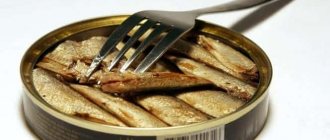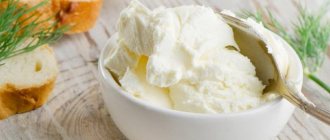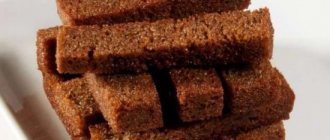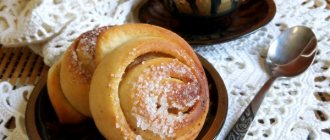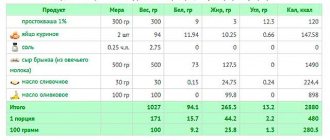Properties of fried onions
Nutritional value and composition | Vitamins | Minerals
How much does fried onion cost (average price for 1 kg)?
Moscow and Moscow region.
960 rub.
Perhaps for some, fried onions are a rare disgusting thing with their unpleasant pungent smell and disgusting taste, and for some it is difficult to imagine breakfast, lunch or dinner without this product. As they say, tastes differ. Meanwhile, the main lover and connoisseur of fried onions is the Jewish nation, whose representatives not only know a lot about it, but also know how to prepare it as a seasoning for main dishes, as well as as an independent dish.
Walking through the quiet streets of Odessa, you can not only hear the dialect typical of these places, but also feel the familiar aroma of fried onions and fish. In addition, even in such a romantic country as France, they also know first-hand what fried onions are - an example of this is the traditional French dish known throughout the world - “French fried onions”. Indonesians also appreciate this strong-smelling but extremely healthy vegetable.
It would seem that there is nothing simpler than frying onions, but this matter has its own subtleties and secrets. The fact is that real fried onions can only be obtained from chopped and dried onions, which are fried with the addition of oil, and after special processing they turn into a spice.
Such fried onions are most often used in various areas of the food industry - in particular, in the production of semi-finished products, pates and sausages. In addition, it is included in a number of instant products: soups, cereals, mashed potatoes, frozen foods.
This seasoning is especially popular in the manufacture of baked goods - for example, when baking onion buns and bread. Fried onions, which have enhanced aromatic properties, are used in the preparation of sauces and ketchups. This spice is found on sale in crushed or ground form, as well as in the form of flakes with a characteristic golden hue.
Benefits of fried onions
Of course, fresh onions are much healthier than fried ones, but in addition to excellent gastronomic qualities, fried onions also have something to boast about.
For example, despite the high calorie content of onions, their benefit lies in the presence of vitamins and minerals that are preserved after frying. Even those people who are on a diet can eat fried onions if instead of some of the oil for frying the onions, add a little water and cook the onions without a lid.
If we talk about the dangers of fried onions, it lies in the fact that they do not benefit the liver. Also, during heat treatment, some of the beneficial substances are lost, of which there are still many in the finished product.
Hidden “friends” and “enemies” in bread
In order to understand the above issue, it is not enough to understand how many calories are in a piece of bread. It is also necessary to study its composition, as well as analyze its energy value. So, the first “test subject” will be white bread, beloved by everyone with rare exceptions. The calorie content in it relative to the energy value is broken down in the proportion 13%:4%:82%. It is immediately clear that there are an inadmissible amount of carbohydrates here, and, as it becomes clear, those same “slow” carbohydrates that tend to quickly be deposited wherever they are not needed. Why is this happening? The basis of white bread, regardless of the grade - premium, first or second - is baking wheat flour, free of any impurities. For the highest grade, it is processed in such a way that as a result, almost no useful vitamins and microelements that were originally present in the wheat remain. Yeast, salt and water are added to the flour. If the ingredients ended there, it wouldn't be so sad. But the composition includes flavoring and aromatic additives that are not ready to boast of naturalness. As a result, the consumer receives a great smell and taste, but completely empty bread. Its calorie content in this case no longer plays such a decisive role.
Now, for greater contrast, it would not be amiss to take apart grain bread with almost the same calorie content. There are slightly fewer carbohydrates in it - 79%, and, on the contrary, more proteins - 15%, as well as fats - 6%. However, he does not win based on these indicators. To make grain bread, not refined flour freed from any impurities is used, but unground cereal grains. Of course, the product tastes rougher; for those who suddenly switch from one type to another, this may even seem too unusual. But the absolute advantage of such bread is that, thanks to its production technology, it works in the gastrointestinal tract on the principle of a panicle, providing invaluable assistance. As a result, what you should be interested in here is not how many calories are in a piece of bread, but what exactly is included in them. And a lot of things are included: vitamins of groups A, E, PP, and iron, and iodine, and calcium, and sodium, and phosphorus. And, importantly, it is grain bread that best provides the body with vitamin B and natural fiber. For this reason, in fitness nutrition, grain bread holds the palm.
The last thing to consider is rye bread, which has the least calories. The proportions between proteins, fats and carbohydrates remain almost stable - 15%: 6%: 77%, but calorie content may vary slightly. The core of this product is rye flour, and there are at least three varieties of it: peeled, wallpaper and sifted. In addition, there is rye custard bread and rye bread. However, no matter what flour is chosen, the number of calories in bread will not rise above 210 kcal, which is the calorie value for Borodinsky, the most famous among the subspecies of rye. Of course, in many vitamins and microelements, rye bread repeats, for example, grain bread. And at the same time, there are those that are unique to it to a greater extent: vitamin H, manganese, potassium and sulfur. Seeds or seaweed are added to rye bread, which significantly increases the iodine content in it. True, the calorie content of bread may also jump a little. The only thing worth remembering is that it is somewhat difficult for the body to assimilate this type of bread. Moreover, people suffering from high acidity and ulcers are advised to avoid products made from rye flour.
The most famous slogan that we have known since childhood: “Bread is the head of everything.” But recently, followers of a healthy lifestyle have argued that the product is an enemy not only to the figure, but also to health. Gradually, white bread began to disappear from the lists of the most necessary products for losing weight due to its starch and gluten content. They began to replace it with all kinds of bread and various types of bread with the addition of seeds, and yeast began to be replaced with sourdough. To confirm the benefits or harm of bread for your figure, you need to understand its composition and effect on the body.
First of all, bread is a simple carbohydrate, as it contains wheat flour. This product is easily absorbed by the body. Undoubtedly, the product will bring nothing to an inactive person except fat deposits. But for athletes the product is indispensable. Its essence is that the body reacts to the intake of the product by producing insulin, reducing the concentration of sugar in the blood. This slows down muscle breakdown and stimulates muscle growth after exercise.
Baked goods are the easiest way to have a quick snack after a heavy workout. At this time, the body spends energy on muscle restoration and does not convert carbohydrates into subcutaneous fat. Therefore, it is difficult to call bread a useless product. It is especially useful for children, because the growing body absorbs the product more easily, unlike coarsely ground varieties, and uses it to build new tissues. It is worth remembering the hospital diet table, which always contains a piece of white baked goods with butter.
The wheat grains from which bread is made contain a large amount of B vitamins and fiber. This group supports the nervous system, cardiovascular system, and also improves the condition of the skin, nails and hair. Of course, during processing, cleaning, and grinding of grains, most of the vitamins are lost, and fiber disappears completely. Therefore, it is worth considering that the content of useful substances varies depending on the grinding, type and method of preparation of the product.
The human body uses calories from food to maintain vital functions. The daily calorie intake can range from 2200 – 3000 kcal for women and 2500 – 3500 kcal for men, depending on lifestyle. The more active the day, the more calories are needed to restore the body and maintain physical and mental strength. Bread is one of those foods that can quickly fill you up and provide a sufficient amount of energy from a small portion. Let's consider the calorie content of the product, depending on the cooking method.
In addition to its high calorie content, the product has a high glycemic index (GI), that is, the ability to cause the body to react to glucose. Where does the sugar in bread come from? - you ask - After all, he is not sweet. The bottom line is that the simple carbohydrates contained in the composition are sugar, and they are broken down into sucrose. Eating a piece of bread releases the hormone insulin, which lowers blood sugar levels. Thanks to insulin, diabetes does not develop.
Constant consumption of foods with a high glycemic index can lead to diabetes, as insulin gradually fails to cope with high sugar levels in the body. Of course, the disease will not develop from one piece a day; you just need to know when to stop everything. You don't have to give up your favorite foods, just reduce their quantity.
High-calorie foods with a high GI index lead to the accumulation of subcutaneous fat. Since the simple carbohydrate in bread is quickly absorbed, the body does not have time to use it as energy, and the carbohydrate goes into fat. Bread is especially harmful in the evening and at night, since the body is already preparing for sleep, instantly storing reserves in the form of fat when receiving both simple and complex carbohydrates.
During manufacturing, the product loses fiber - solid dietary fiber, which has a beneficial effect on the intestines, saturating the body with energy, vitamins and minerals. Unfortunately, white bread lacks fiber, and this can lead to intestinal dysfunction.
Recipe: Onions fried in sunflower oil. Calorie, chemical composition and nutritional value.
Nutritional value and chemical composition of “Onions fried in sunflower oil.”
The table shows the nutritional content (calories, proteins, fats, carbohydrates, vitamins and minerals) per 100 grams of edible portion.
| Nutrient | Quantity | Norm** | % of the norm in 100 g | % of the norm in 100 kcal | 100% normal |
| Calorie content | 251 kcal | 1684 kcal | 14.9% | 5.9% | 671 g |
| Squirrels | 1.3 g | 76 g | 1.7% | 0.7% | 5846 g |
| Fats | 24.7 g | 56 g | 44.1% | 17.6% | 227 g |
| Carbohydrates | 5.6 g | 219 g | 2.6% | 1% | 3911 g |
| Organic acids | 0.1 g | ~ | |||
| Alimentary fiber | 2.8 g | 20 g | 14% | 5.6% | 714 g |
| Water | 63.5 g | 2273 g | 2.8% | 1.1% | 3580 g |
| Ash | 0.492 g | ~ | |||
| Vitamins | |||||
| beta carotene | 0.001 mg | 5 mg | 500000 g | ||
| Vitamin B1, thiamine | 0.034 mg | 1.5 mg | 2.3% | 0.9% | 4412 g |
| Vitamin B2, riboflavin | 0.018 mg | 1.8 mg | 1% | 0.4% | 10000 g |
| Vitamin B4, choline | 5.45 mg | 500 mg | 1.1% | 0.4% | 9174 g |
| Vitamin B5, pantothenic | 0.089 mg | 5 mg | 1.8% | 0.7% | 5618 g |
| Vitamin B6, pyridoxine | 0.083 mg | 2 mg | 4.2% | 1.7% | 2410 g |
| Vitamin B9, folates | 3.541 mcg | 400 mcg | 0.9% | 0.4% | 11296 g |
| Vitamin C, ascorbic acid | 5.41 mg | 90 mg | 6% | 2.4% | 1664 g |
| Vitamin E, alpha tocopherol, TE | 10.997 mg | 15 mg | 73.3% | 29.2% | 136 g |
| Vitamin H, biotin | 0.841 mcg | 50 mcg | 1.7% | 0.7% | 5945 g |
| Vitamin K, phylloquinone | 1.7 mcg | 120 mcg | 1.4% | 0.6% | 7059 g |
| Vitamin RR, NE | 0.418 mg | 20 mg | 2.1% | 0.8% | 4785 g |
| Niacin | 0.167 mg | ~ | |||
| Macronutrients | |||||
| Potassium, K | 137.7 mg | 2500 mg | 5.5% | 2.2% | 1816 |
| Calcium, Ca | 24.39 mg | 1000 mg | 2.4% | 1% | 4100 g |
| Silicon, Si | 2.459 mg | 30 mg | 8.2% | 3.3% | 1220 g |
| Magnesium, Mg | 11.02 mg | 400 mg | 2.8% | 1.1% | 3630 g |
| Sodium, Na | 3.15 mg | 1300 mg | 0.2% | 0.1% | 41270 g |
| Sera, S | 60.74 mg | 1000 mg | 6.1% | 2.4% | 1646 g |
| Phosphorus, Ph | 46.1 mg | 800 mg | 5.8% | 2.3% | 1735 g |
| Chlorine, Cl | 19.67 mg | 2300 mg | 0.9% | 0.4% | 11693 g |
| Microelements | |||||
| Aluminium, Al | 196.7 mcg | ~ | |||
| Bor, B | 98.4 mcg | ~ | |||
| Iron, Fe | 0.63 mg | 18 mg | 3.5% | 1.4% | 2857 g |
| Yod, I | 2.1 mcg | 150 mcg | 1.4% | 0.6% | 7143 g |
| Cobalt, Co | 3.934 mcg | 10 mcg | 39.3% | 15.7% | 254 g |
| Manganese, Mn | 0.1131 mg | 2 mg | 5.7% | 2.3% | 1768 |
| Copper, Cu | 71.9 mcg | 1000 mcg | 7.2% | 2.9% | 1391 g |
| Nickel, Ni | 1.475 mcg | ~ | |||
| Rubidium, Rb | 234.1 mcg | ~ | |||
| Selenium, Se | 0.433 mcg | 55 mcg | 0.8% | 0.3% | 12702 g |
| Fluorine, F | 15.25 mcg | 4000 mcg | 0.4% | 0.2% | 26230 g |
| Chromium, Cr | 0.98 mcg | 50 mcg | 2% | 0.8% | 5102 g |
| Zinc, Zn | 0.719 mg | 12 mg | 6% | 2.4% | 1669 g |
| Digestible carbohydrates | |||||
| Starch and dextrins | 0.089 g | ~ | |||
| Mono- and disaccharides (sugars) | 6.4 g | max 100 g | |||
| Glucose (dextrose) | 1.279 g | ~ | |||
| Sucrose | 6.393 g | ~ | |||
| Fructose | 1.18 g | ~ | |||
| Essential amino acids | 0.281 g | ~ | |||
| Arginine* | 0.157 g | ~ | |||
| Valin | 0.025 g | ~ | |||
| Histidine* | 0.014 g | ~ | |||
| Isoleucine | 0.039 g | ~ | |||
| Leucine | 0.049 g | ~ | |||
| Lysine | 0.059 g | ~ | |||
| Methionine | 0.01 g | ~ | |||
| Methionine + Cysteine | 0.02 g | ~ | |||
| Threonine | 0.039 g | ~ | |||
| Tryptophan | 0.02 g | ~ | |||
| Phenylalanine | 0.04 g | ~ | |||
| Phenylalanine+Tyrosine | 0.069 g | ~ | |||
| Nonessential amino acids | 0.652 g | ~ | |||
| Alanin | 0.057 g | ~ | |||
| Aspartic acid | 0.069 g | ~ | |||
| Glycine | 0.04 g | ~ | |||
| Glutamic acid | 0.216 g | ~ | |||
| Proline | 0.03 g | ~ | |||
| Serin | 0.027 g | ~ | |||
| Tyrosine | 0.03 g | ~ | |||
| Cysteine | 0.013 g | ~ | |||
| Sterols (sterols) | |||||
| beta sitosterol | 49.18 mg | ~ | |||
| Saturated fatty acids | |||||
| Saturated fatty acids | 2.8 g | max 18.7 g | |||
| 16:0 Palmitinaya | 1.525 g | ~ | |||
| 18:0 Stearic | 1.008 g | ~ | |||
| 20:0 Arakhinovaya | 0.074 g | ~ | |||
| 22:0 Begenovaya | 0.172 g | ~ | |||
| Monounsaturated fatty acids | 5.852 g | min 16.8 g | 34.8% | 13.9% | |
| 18:1 Oleic (omega-9) | 5.828 g | ~ | |||
| Polyunsaturated fatty acids | 15.984 g | from 11.2 to 20.6 g | 100% | 39.8% | |
| 18:2 Linolevaya | 14.705 g | ~ | |||
| Omega-6 fatty acids | 14.7 g | from 4.7 to 16.8 g | 100% | 39.8% |
The energy value of onions fried in sunflower oil is 251 kcal.
Primary Source: Created in the application by the user. Read more.
** This table shows the average levels of vitamins and minerals for an adult. If you want to know the norms taking into account your gender, age and other factors, then use the “My Healthy Diet” application.
How many calories are in bread
If you conduct a survey on the topic of the greatest harm to the figure from a certain type of bread, the one made from premium wheat flour, with a crispy golden crust and an airy crumb, will definitely take the lead. Sometimes you even want to eat it without anything, like a bun - its taste is so delicate. And it seems that the calorie content of white bread is an order of magnitude higher than “gray” bread - baked from second-grade flour. Alas. Even in comparison with black bread, the calorie content of white bread is not so significant - they float within almost the same limits. For a premium bun, this figure is 225 kcal per 100 g, and for the healthiest option, according to many, black with seaweed, it will be even four kilocalories higher: 229 kcal per 100 g. Next to it is Borodinsky, which has 201 kcal , and grain – 228 kcal. Rye bread has the lowest calorie content: it contains only 168 kcal.
In this case, the question arises: if the number of calories in a piece of bread is approximately the same, why is the risk of gaining weight higher from white bread than from black bread? And why exactly are they not advised to abuse them?
